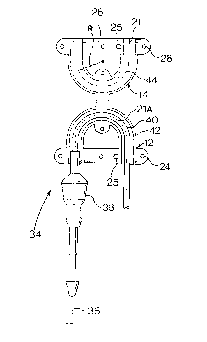Some of the information on this Web page has been provided by external sources. The Government of Canada is not responsible for the accuracy, reliability or currency of the information supplied by external sources. Users wishing to rely upon this information should consult directly with the source of the information. Content provided by external sources is not subject to official languages, privacy and accessibility requirements.
Any discrepancies in the text and image of the Claims and Abstract are due to differing posting times. Text of the Claims and Abstract are posted:
| (12) Patent Application: | (11) CA 2246264 |
|---|---|
| (54) English Title: | A KINK INHIBITING DEVICE |
| (54) French Title: | DISPOSITIF UTILISE POUR ELIMINER LES TORSIONS |
| Status: | Deemed Abandoned and Beyond the Period of Reinstatement - Pending Response to Notice of Disregarded Communication |
| (51) International Patent Classification (IPC): |
|
|---|---|
| (72) Inventors : |
|
| (73) Owners : |
|
| (71) Applicants : |
|
| (74) Agent: | SMART & BIGGAR LP |
| (74) Associate agent: | |
| (45) Issued: | |
| (22) Filed Date: | 1998-09-02 |
| (41) Open to Public Inspection: | 1999-03-02 |
| Availability of licence: | N/A |
| Dedicated to the Public: | N/A |
| (25) Language of filing: | English |
| Patent Cooperation Treaty (PCT): | No |
|---|
| (30) Application Priority Data: | ||||||
|---|---|---|---|---|---|---|
|
A kink inhibiting device is provided for inhibiting kinking in a length of
curved flexible tubing, and in particular IV or drip tubing. The device
comprises a pair of U-shaped shell halves which are joined back-to-back at
their bight portions by an integral hinge formation. The shell halves each
define channels having semi-circular cross-sectional profiles, and are formed
with connecting lands carrying studs and complemental apertures for
allowing the shell halves to mate with one another. The shell halves each
have a radius of curvature (R) which is greater than the maximum radius of
curvature at which the flexible tubing starts to kink when unsupported.
Dispositif utilisé pour éliminer les torsions dans une section de tube souple incurvée, en particulier un tube d'intraveineuse ou de perfusion. Le dispositif comprend une paire de demi-coquilles en U, unies dos-à-dos au niveau de leur section de boucle, au moyen d'une charnière intégrée. Les demi-coquilles sont dotées l'une et l'autre de rainures transversales semi-circulaires et comportent des surfaces d'appui munies de tiges et d'ouvertures complémentaires pour assurer leur assemblage. Les demi-coquilles ont toutes deux un rayon de courbure (K) supérieur au rayon de courbure maximal auquel un tube souple, non supporté, commence à se tordre.
Note: Claims are shown in the official language in which they were submitted.
Note: Descriptions are shown in the official language in which they were submitted.

2024-08-01:As part of the Next Generation Patents (NGP) transition, the Canadian Patents Database (CPD) now contains a more detailed Event History, which replicates the Event Log of our new back-office solution.
Please note that "Inactive:" events refers to events no longer in use in our new back-office solution.
For a clearer understanding of the status of the application/patent presented on this page, the site Disclaimer , as well as the definitions for Patent , Event History , Maintenance Fee and Payment History should be consulted.
| Description | Date |
|---|---|
| Inactive: IPC from MCD | 2006-03-12 |
| Inactive: IPC from MCD | 2006-03-12 |
| Inactive: IPC from MCD | 2006-03-12 |
| Application Not Reinstated by Deadline | 2002-09-03 |
| Time Limit for Reversal Expired | 2002-09-03 |
| Deemed Abandoned - Failure to Respond to Maintenance Fee Notice | 2001-09-04 |
| Application Published (Open to Public Inspection) | 1999-03-02 |
| Inactive: Correspondence - Formalities | 1998-12-02 |
| Inactive: IPC assigned | 1998-11-21 |
| Inactive: First IPC assigned | 1998-11-21 |
| Classification Modified | 1998-11-10 |
| Inactive: IPC assigned | 1998-11-10 |
| Inactive: Filing certificate - No RFE (English) | 1998-10-21 |
| Filing Requirements Determined Compliant | 1998-10-21 |
| Application Received - Regular National | 1998-10-16 |
| Abandonment Date | Reason | Reinstatement Date |
|---|---|---|
| 2001-09-04 |
The last payment was received on 2000-08-31
Note : If the full payment has not been received on or before the date indicated, a further fee may be required which may be one of the following
Please refer to the CIPO Patent Fees web page to see all current fee amounts.
| Fee Type | Anniversary Year | Due Date | Paid Date |
|---|---|---|---|
| Application fee - small | 1998-09-02 | ||
| MF (application, 2nd anniv.) - small | 02 | 2000-09-05 | 2000-08-31 |
Note: Records showing the ownership history in alphabetical order.
| Current Owners on Record |
|---|
| JUSTIN COLLEN |
| Past Owners on Record |
|---|
| None |